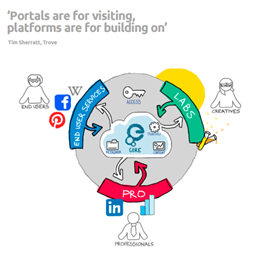Meet the Members Council: Laura Carletti

Last year, we ran the Meet the Members Council blog series so you could hear directly from each of your elected Members Council representatives, and get to know them a little better. In November, you elected seven further members to this Council, each of whom will introduce themselves via this blog in the coming weeks.
I first came across Europeana through EuropeanaLocal, a Best Practice Network, funded by the European Commission under the eContentplus programme. The project was designed to help local and regional libraries, museums, and archives make their content available on Europeana. Although the project dates back to 2008, I still have vivid memories of entering the Europeana’s world of metadata standards and interoperability, and of the organisational complexities of connecting the local and the EU levels.
EuropeanaLocal was an exciting project. However, I didn’t have the chance to be involved until its conclusion, as in 2009 I started my PhD in Technology and Learning Sciences. My PhD research focused on digital engagement strategies and the use of social media by spontaneous online communities. I explored amateurism and crowdsourcing by studying the Ghostsigns project, an initiative aiming to photograph and preserve faded painted wall advertising signs. This was a pioneering example, led by an amateur, of co-creating a digital collection through social media. The collection was later ‘institutionalised’ in the archive of the History of Advertising Trust UK.
The Ghostsigns study showed that crowdsourcing can be a powerful mechanism of engagement, as well as an effective co-creation process. Moreover, the study revealed the challenges of integrating public-generated content into institutional repositories, and raised interesting questions such as: How do we draw boundaries between ‘official’ and externally-generated knowledge? How can the professional framed context and metadata standards be connected with the just-in-time, emergent nature of amateur online collection and curation? Shall user-generated content be hosted by the organisation or separated, hosted by social media platforms or personal blogs?
The museum as a platform
Those open issues are still central in my research and since 2010 I have been based in Horizon - the multidisciplinary research centre on the impact of digital technologies - at the University of Nottingham, expanding my work on co-creation practices, crowdsourcing, and public humanities. Among others, I worked on the ‘ArtMaps’ project, which developed a crowdsourcing platform in collaboration with Tate and the University of Exeter to explore different ways of engaging the audience and visualising the Tate digital collection.
ArtMaps provided insights into the notion of the museum as platform, and stimulated considerations about the preservation of audience-generated content, the implications of open ended vs. framed experiences for the public, and the use of third-party platforms. The reflections and findings generated by the ArtMaps research are also valuable in the EU context. Europeana, as indicated in the Strategy 2015-2020, aims to evolve from a portal into a “platform for cultural heritage”, “a place not only to visit, but also to build on, play in and create with.”

Diagram from Europeana's Strategy 2015-2020, p.11.
New forms of interaction
In my research practice, I regularly collaborate with heritage institutions in co-creating alternative forms of visitors’ interactions with archival resources and digital collections. For instance, within ArtMaps, I designed Web-based activities to experiment with online audience engagement; I coordinated ‘Hidden Stories of Venice’, a digital storytelling experience linked to the EM15 collateral exhibition at the Venice Biennale 2015; and I curated the digital interactivity of ‘Uncovering the Invisible’, a temporary and touring photo exhibition by Pablo and Roxana Alison. Coherently with the Europeana Strategy and in line with my theoretical and practical background, I am willing to contribute to advance Europeana as creative platform to aggregate people and content.
In the Europeana Strategy it is also highlighted that only 10% of the European heritage is digitally available. While endeavours to increase the digitisation of the remaining 90% continue, I am convinced that we need to commit further in designing experiences for the public to explore and engage with the millions objects digitally available. There are some great examples already implemented such as Europeana 1914-1918, mixing resources on World War I from libraries and archives, as well as crowdsourced memories and memorabilia from families throughout Europe. My belief is that we need to experiment more in this direction and, in my new role as councillor, I will strive to promote Europeana as public engagement space, starting by actively supporting the ongoing #AllezCulture campaign.
